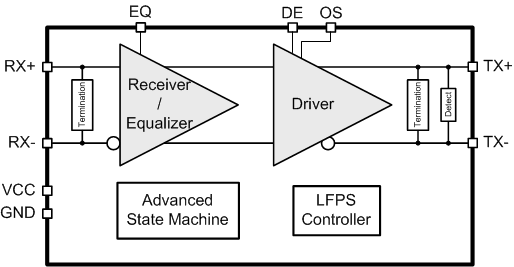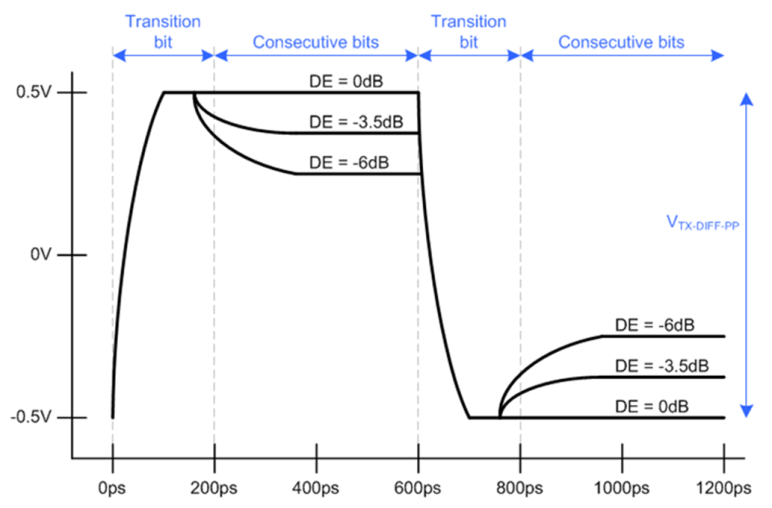SLLSEJ1A March 2014 – March 2014 TUSB551
PRODUCTION DATA.
- 1 Features
- 2 Applications
- 3 Description
- 4 Simplified Schematic
- 5 Revision History
- 6 Terminal Configuration and Functions
-
7 Specifications
- 7.1 Absolute Maximum Ratings
- 7.2 Handling Ratings
- 7.3 Recommended Operating Conditions
- 7.4 Thermal Information
- 7.5 Power Supply Electrical Characteristics
- 7.6 DC Electrical Characteristics
- 7.7 AC Electrical Characteristics
- 7.8 Timing Requirements/Timing Diagrams
- 7.9 Switching Characteristics
- 7.10 Typical Characteristics
- 8 Detailed Description
- 9 Applications and Implementation
- 10Power Supply Recommendations
- 11Layout
- 12Device and Documentation Support
- 13Mechanical, Packaging, and Orderable Information
Package Options
Mechanical Data (Package|Pins)
- RWB|12
Thermal pad, mechanical data (Package|Pins)
Orderable Information
8 Detailed Description
8.1 Overview
When 5Gbps SuperSpeed USB signals travel across a PCB or cable, signal integrity degrades due to loss and inter-symbol interference. The TUSB551 recovers incoming data by applying equalization that compensates for channel loss, and drives out signals with a high differential voltage. This extends the possible channel length, and enables systems to pass USB 3.0 compliance.
The TUSB551 advanced state machine makes it transparent to hosts and devices. After power up, the TUSB551 periodically performs receiver detection on the TX pair. If it detects a SuperSpeed USB receiver, the RX termination is enabled, and the TUSB551 is ready to re-drive.
The device’s ultra low-power architecture operates at a 1.8V power supply and achieves enhanced performance. The receiver equalizer has three gain settings that are controlled by terminal EQ: 3 dB, 6 dB, and 9 dB. The equalization should be set based on amount of insertion loss in the channel before the TUSB551. Likewise, the output driver supports configuration of De-Emphasis and Output Swing (terminals DE and OS). The automatic LFPS De-Emphasis control further enables the system to be USB3.0 compliant.
The TUSB551 operates over the industrial temperature range of -40ºC to 85ºC in the 1.6mm x 1.6mm X2QFN package.
8.2 Functional Block Diagram

8.3 Feature Description
8.3.1 Receiver Equalization
The purpose of receiver equalization is to compensate for channel insertion loss and inter-symbol interference in the system before the input of the TUSB551. The receiver overcomes these losses by attenuating the low frequency components of the signals with respect to the high frequency components. The proper gain setting should be selected to match the channel insertion loss before the input of the TUSB551.
8.3.2 De-Emphasis Control and Output Swing
The differential driver output provides selectable de-emphasis and output swing control in order to achieve USB3.0 compliance. The TUSB551 offers a unique way to adjust output de-emphasis and transmitter swing based on the OS and DE terminals. The level of de-emphasis required in the system depends on the channel length after the output of the re-driver.
 Figure 10. Transmitter Differential Voltage, OS=Floating
Figure 10. Transmitter Differential Voltage, OS=Floating8.3.3 Automatic LFPS Detection
The TUSB551 features an intelligent low frequency periodic signaling (LFPS) controller. The controller senses the low frequency signals and automatically disables the driver de-emphasis, for full USB3.0 compliance.
8.4 Device Functional Modes
8.4.1 Receiver Equalization Settings
| TERMINAL | DESCRIPTION | LOGIC STATE | GAIN |
|---|---|---|---|
| EQ | Equalization amount | Low | 3 dB |
| Floating (NC) | 6 dB | ||
| High | 9 dB |
8.4.2 De-Emphasis Control Settings
| TERMINAL | INTERNAL TIE | LOGIC STATE | DE-EMPHASIS RATIO | |
|---|---|---|---|---|
| FOR OS = LOW | FOR OS = FLOATING | |||
| DE | De-emphasis amount | Low | 0 dB | 0 dB |
| Floating (NC) | -2 dB | -3.5 dB | ||
| High | -4 dB | -6 dB | ||
8.4.3 Output Swing Control Settings
| TERMINAL | INTERNAL TIE | LOGIC STATE | OUTPUT DIFFERENTIAL VOLTAGE |
|---|---|---|---|
| OS | Output swing amplitude, DE = Low |
Low | 1050 mVpp |
| Floating (NC) | 1200 mVpp |